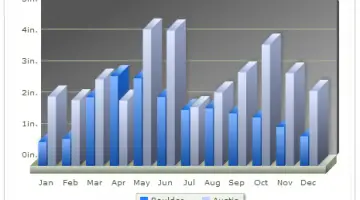Much of the West Coast, even Hawaii, has enjoyed, or suffered through, major storms this winter, and NorCal is in the middle of one of the wettest years on record, causing major flooding, dam damage and road damage:
Without a doubt, there are more important things during such storms than our two-wheel recreation and adventures, and we hope anyone impacted by the massive storms remains safe and dry.
However, with near-constant rain out West (much of which was needed due to a years-long drought), we were curious about the weather patterns we’ve been facing and whether we and our readers can expect more of the same in the coming months. Can we can safely justify some wet-weather cycling-related purchases that we might be lacking, whether it’s purchasing a set of fenders, waterproof socks, outer layers or even acquiring a rain bike without fear that the current storm is our last?
A year and a half ago, with all the talk of El Niño and the Blob, we caught up with cyclocrosser, photographer and meteorologist Steve Anderson as we entered into the 2015 cyclocross season to get his predictions on weather and cyclocross gear and mud tire needs. That year we were underwhelmed by the number of muddy races, but now suddenly, we’re in a deluge with little pre-winter talk of any weather predictions.
So we caught up with CXM’s own weather-predicting groundhog to better understand our current weather, and learn whether West Coast racers need mud tires for their gravel or mixed-terrain adventures and races.
Cyclocross Magazine: Maybe we weren’t listening well but unlike the last few years there seemed to be little talk of El Niño or La Niña before this winter. Were there any predictions of such a wet winter this fall? Was this record-breaking winter foreseen at all?
Steve Anderson: We have been in a weak La Niña this past winter. The effects El Niño, which are more rain, and La Niña, which are less rain, have a higher likelihood of happening when the Niños and Niñas are strong. However, not all strong El Niño or La Niña winters will have more or less rainfall. This year’s weather is just one of those anomalies.
“We have been in a weak La Niña this past winter. This year’s weather is just one of those anomalies.”
CXM: For those of us still feeling unprepared without enough wet riding gear or indoor trainers or gym memberships, how much does the past few months’ weather predict the weather during next few months? Do storms attract more storms? Is it still worth making a few purchases without fearing the next storm is the last?
SA: The past few months will have little to do with the next few months. Computer weather models are really only reliable out to seven days. However we do seem to be in a prolonged wet weather pattern that seems to want to stick around.
CXM: For spring and summer mountain bike and gravel rides in the Sierra, would you predict we’ll need mud tires for much of the offseason due to the snowpack? Snow levels are high, not just reservoirs?
SA: I would expect the snowpack to remain for a while. Skiing until July 4th in some areas will be possible. Mountain bike parks in the Sierra may have to plow the snow away to open. Might be a good year for the fat bikes on the snow.
CXM: Northern California seems to be breaking records and spillways but are there other areas in the West that are also setting records for snow or rain?
SA: Not that I’m aware of.
CXM: As a weatherman and cyclist and photographer, does the recent weather impact your riding time with increased work, or are you more motivated to get out when it’s nice because you know what’s coming next?
SA: I am definitely more motivated to get out for a training ride with less time before and after work. Having knowledge of when the windows of dry weather will open up is definitely a big help.

Weatherman Steve Anderson racing home to predict the weather and keep people safe. © Jeff Vander Stucken
CXM: We’ve had bad drought years and now a super wet year. Any way to know whether either or both are to blame on global warming?
SA: During climate change we will see more extreme weather events. The past wet year can not be to blamed on climate change. The time scales are different. Climate change has a much longer time scale than just one wet year or even four or five years of drought.
CXM: Any weather predictions for next winter, El Niño, La Niña and Reno?
SA: No weather signals, including El Niño or La Niña are being observed at this time to indicate what the weather would be like in Reno next winter. I would use climatology to make the forecast out that far, believing what has happened in the past may likely happen in the future. However this is not always the case with climate change thrown in the mix.
Past weather stats for Reno on Jan. 8th
| Year | High | Low | Precip Rain/Snow | Snow on ground |
|---|---|---|---|---|
| 2017 | 49 | 35 | 1.44” (rain) | Snow on ground 3” |
| 2016 | 42 | 25 | 0.00” | Snow on ground 1” |
| 2015 | 56 | 25 | 0.00” | Snow on ground 0” |
| 2014 | 50 | 27 | 0.00” | Snow on ground 0” |
| 2013 | 48 | 23 | 0.00” | Snow on ground 1” |
| 2012 | 46 | 21 | 0.00” | Snow on ground 0” |
| 2011 | 47 | 20 | 0.00” | Snow on ground 0” |
| 2010 | 48 | 33 | 0.01” | Snow on ground 1” |
| 2009 | 60 | 30 | 0.00” | Snow on ground 0” |
| 2008 | 40 | 21 | .06” (rain) | Snow on ground 6” |
| 2007 | 50 | 20 | 0.00” | Snow on ground 0” |
| 2006 | 48 | 29 | 0.00” | Snow on ground 0” |
| 2005 | 35 | 29 | 10.5” (snow) | Snow on ground 13” |
CXM: Your prediction for Nationals?
SA: My Forecast for Reno Jan 8th 2018: Variable clouds. Highs in the Mid 40s. Lows in the Mid 20s. Southerly winds 5-15 mph with locally higher gusts. Chance of rain/snow 20%.


































